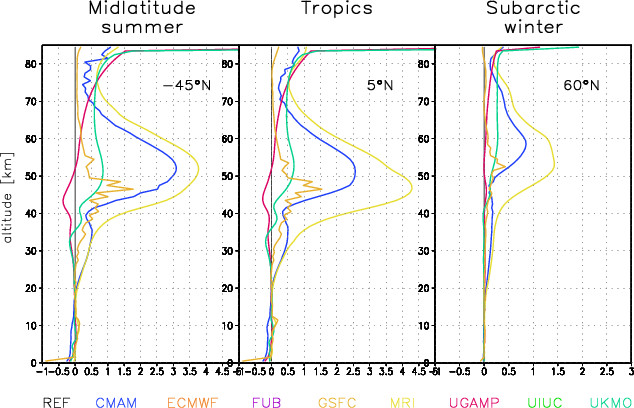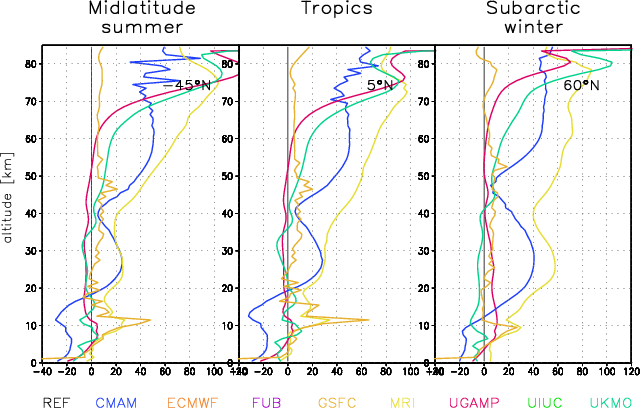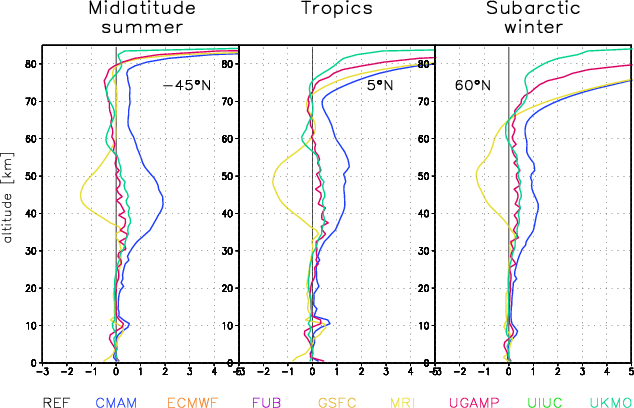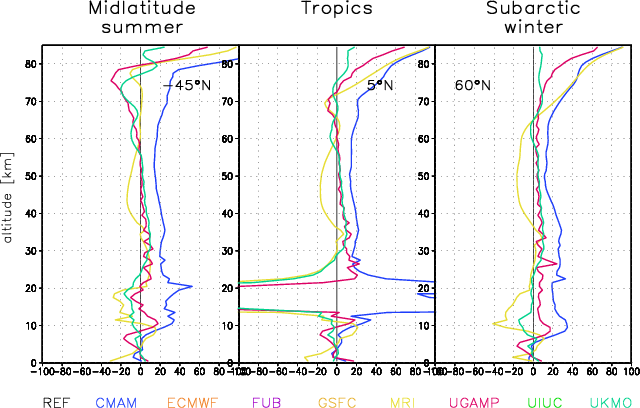Task 2a: Radiation Scheme Intercomparison
The GRIPS-project is meant as an extension to the Intercomparison of Radiation Codes in Climate Models (ICRCCM) study, a program co-sponsored by the Department of Energy (DOE), the World Meteorological Organization (WMO), and the International Radiation Commission (IRC).
Its goal is to compare and analyze the impact of the different parametrizations in radiation schemes used in the GRIPS-MA-GCMs on climatological temperature and its bias, since their formulations are supposed to be responsible for the systematic temperature biases of many Middle Atmosphere General Circulation Models (MA-GCMs).
The absorption and emission of radiation by gases and aerosols in the atmosphere is strongly dependent on the incident wavelength, so that radiation models with high spectral resolution, ideally line-by-line or narrow band models, are needed to accurately simulate radiative transfer in the atmosphere. However, due to the high computational resources needed by such models, broad-band radiation parametrizations are commonly used in MA-GCMs.
Participating models:
The participating MA-GCMs of Phase 1 are listed in Table 1. As reference, longwave heating rates from the GENLN2 line-by-line model and shortwave heating rates from a narrow-band-model were provided by W. Zhong, Imperial College, London, UK. Details of the reference models are given in Table 2 and the informations about used radiation codes in Table 3.
The inputdata can be seen here as a table or as 2D-plots.
Method:
For the better comparison of the data sets an offline computation of radiative heating rates will be performed, using radiation schemes of GRIPS-GCMs and identical standard input data. The radiation codes will be compared with each other and with the reference model.
Furthermore the sensitivity of the radiation schemes to changes of trace gas vertical profiles has to be studied.
Results:
The specific goal of this intercomparison is to validate the MA-GCM radiation codes by comparing with high resolution reference calculations:
In Phase 1, defined experiments using standardized input data for temperature, trace gas concentrations and solar parameters were performed. Required output data were vertical profiles of zonal mean heating rates for January mean conditions.
a

b

Fig.1: Shortwave heating rates for January at 45°S, a) absolute profiles of CMAM radiation codes and reference model in K/day; b) deviations of CMAM radiation codes from reference model in K/day and c) deviations of CMAM radiation codes from reference model in % of reference model.
Dashed lines indicate models using a different vertical grid.
a

b

Fig.2: Longwave heating rates for January at 60°N, a) absolute profiles of CMAM radiation codes and reference model in K/day; b) deviations of CMAM radiation codes from reference model in K/day and c) deviations of CMAM radiation codes from reference model in % of reference model. Dashed lines indicate models using a different vertical grid.
Fig. 1 shows vertical profiles of the shortwave heating rates from the different parametrizations for a midlatitude summer atmosphere (45°S). In the stratopause height region around 50 km, differences of up to 5 K/day occur between the radiation codes (Fig.1a). Compared to the shortwave reference model, most parametrizations yield higher heating rates over the whole vertical range, reaching maximum deviations of 3.8 K/day at 53 km (Fig.1b). Sensitive altitude regions are the tropopause area and the middle stratosphere (20-30 km), where the reference heating rates are overestimated up to 20 % (Fig.1c). There is also a general tendency of increasing errors with height in the upper mesosphere.
In contrast, errors in the parametrizations of longwave radiative transfer, shown here for a high latitude winter atmosphere (60°N), are less pronounced (Fig.2). Deviations between the radiation codes do not exceed 3 K/day below 70 km (Fig2a), whereas deviations from the reference model range from -1 to +1 K/day.
The combined effect yields net heating rates which differ not only in magnitude, but also in sign. Due to the large discrepancies in the shortwave heating, the different MA-GCMs show either a net radiative warming or a net cooling of the middle stratosphere high latitudes in summer.
The magnitude of these discrepancies, which are due to the individual formulations of the radiation codes, exceed those which arise from the consideration of additional absorbing gases. Taking into account the effect of CH4 and N2O leads to an enhanced cooling of the tropical tropopause region between 0.03 and 0.05 K/day -depending on the radiation model- and to a stronger warming of the summer stratopause up to 0.25 K/day.

